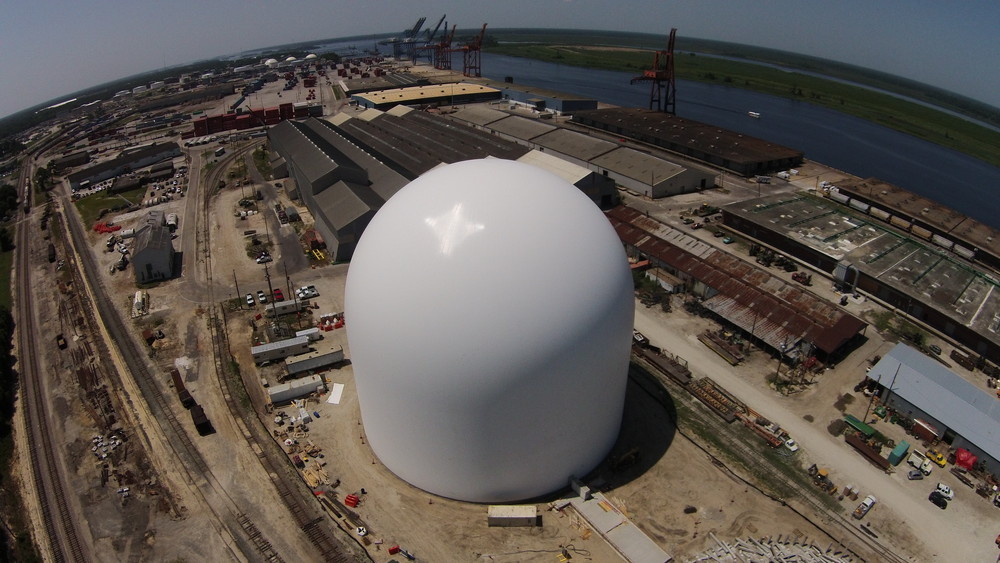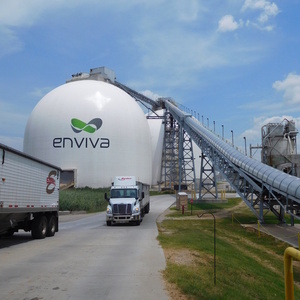Enviva's third quarter results report on track pellet operations







Photo: Katie Fletcher
November 11, 2015
BY Katie Fletcher
Enviva Partners LP recently released its third quarter financial results, reporting progress on the potential acquisition of the Southampton pellet plant and that both the Wilmington terminal and Sampson plant are on track to begin operations in early 2016.
The operational 510,000 metric-ton-per-year wood pellet production plant in Southampton County, Virginia, is currently owned and operated by the company’s sponsor. The sponsor has proposed a 10-year, 500,000 metric-ton-per-year (MTPY) offtake agreement (385,000 metric tons for the first year), which is being evaluated by a conflicts committee. The Enviva partnership continues to discuss the terms, including financing of the proposed transaction, and it expects to complete the transaction in the fourth quarter of 2015.
In addition, both the 515,000 MTPY production plant in Sampson County, North Carolina, and a deep-water marine terminal in Wilmington, North Carolina, are on track to begin operations in the first quarter of 2016. The partnership anticipates it will have the opportunity to acquire the Sampson plant with a 10-year offtake contract late next year, and the Wilmington terminal in 2017. Preparation to begin construction on an additional 500,000 MTPY production plant on a site owned by the partnership’s sponsor in Hamlet, North Carolina, is also underway.
For the third quarter of 2015, Enviva Partners generated net revenue of $116.6 million, a $40.5 million, or 53 percent, increase over the third quarter of last year. Net income of $6.4 million was generated in quarter three compared to $3.1 million for the corresponding quarter in 2014. According to the partnership, the increase in revenue was primarily the result of additional contracted sales volume and improved customer mix. The increase in net income was a result of these higher revenues partially offset by higher general and administrative costs, including costs associated with being a public company.
Advertisement
Advertisement
Adjusted earnings before interest, tax, depreciation and amortization (EBITDA) improved to $15.9 million in the third quarter, a 59 percent increase compared to the corresponding period in the prior year. The improvement was driven by higher sales volumes, more favorable pricing under customer contracts and lower export shipping costs, according to the company. The improvement was partially offset by the increased costs of delivered wood pellets that were purchased under contract from its sponsor’s Southampton plant this year and higher general and administrative costs.
The partnership’s distributable cash flow for the third quarter was $12.6 million, resulting in a distribution coverage ratio of 1.21 times.
Enviva Partners provided guidance for the remaining quarter in 2015. The partnership expects its existing business to generate net income in the range of $5.6 million to $6.6 million and adjusted EBITDA in the range of $14.8 million to $15.8 million, and to incur maintenance capital expenditures in the range of $500,000 to $1 million and interest expense net of amortization of debt issuance costs and original issue discount of $2.5 million in the fourth quarter of 2015. As a result, the company anticipates distributable cash flow of $11.3 million to $12.3 million during the fourth quarter. Fourth quarter adjusted EBITDA is expected to be slightly below the run rate of prior quarters primarily due to an unfavorable contracted shipment (one of two) inherited as part of the Cottondale plant acquisition, partially offset by a non-recurring utility refund.
Advertisement
Advertisement
“We expect Enviva’s strong year-to-date operating performance to continue in the fourth quarter of 2015 and beyond,” said John Keppler, chairman and CEO of Enviva Partners. “We believe our stable cash flow profile, combined with the anticipated acquisition of the proposed Southampton plant and the benefits from incremental, modest capital investments in our current plants, will provide opportunities to substantially increase our distribution going forward.”
The company shared a market update in its quarter three earnings, highlighting growth in the industry by providing potential pellet demand to come from a number of recent developments. DONG Energy’s coal-to-wood pellet conversion of its 360 MW Studstrup unit 3 and expansion of its 250 MW Avedore unit 1 are on track. The Avedore unit is part of the largest power station in Denmark and Studstrup is already firing wood pellets and straw. Combined, these two power stations are projected to be around 1 million tons starting in 2016. According to the partnership, its sponsor has a 10-year, 420,000 MTPY (385,000 metric tons for the first year) offtake agreement with an affiliate of DONG Energy that commences in September 2016.
Eon’s announcement about the sale of its 556 MW Langerlo power facility in Belgium to German Pellets was part of the market update, and upon its anticipated conversion to wood pellets is projected to require more than 1.5 million tons annually. Macquarie’s MGT Teeside 299 MW renewable energy plant project has initiated the selection of lenders as it continues to progress towards financial close in early 2016 after its U.K. government-based contract for difference (CfD) passed the EU state aid review process. This project is expected to consume more than 1 million tons of wood pellets annually, beginning in early 2019. Additional pellet demand will also come from Drax’s third 660 MW biomass unit, which is currently ramping up to full capacity, and would demand more than 2 million tons annually. Pellet demand will also come from RWE’s 420 MW Lynemouth coal facility in the U.K. It is expected to generate demand for approximately 1.5 million tons of wood pellets per year. These facilities have received confirmation from the U.K. government that they can move forward with their conversions to biomass under the Renewable Obligation Certificate subsidy as an alternative to their previously awarded CfDs did not receive EU state aid approval. The U.S. EPA’s Clean Power Plan was also mentioned in the market update.
“Customers in our core European utility market segment continue to see profitable opportunities to generate renewable energy by converting coal-fired assets to biomass-fired power stations,” Keppler said. “In addition to the highly visible growth in this sector, we are also encouraged by the initial regulatory progress for utility demand in the U.S. and the rapidly growing institutional, industrial and residential heating demand for wood pellets both here and abroad, which our production increasingly has the opportunity to serve.”
Keppler said in the company’s quarter two earnings call that Enviva Partners sees growth in Europe, Asia and the U.S. from broader utility heating and retail sectors, expecting to re-contract volumes in its current portfolio and enter into material additional volumes.
Upcoming Events





